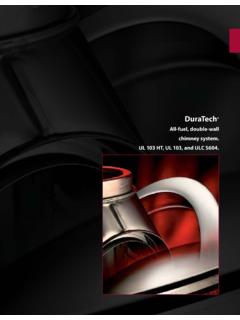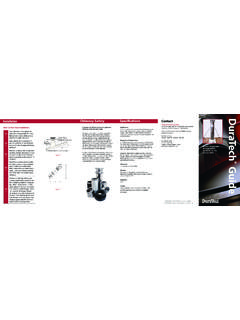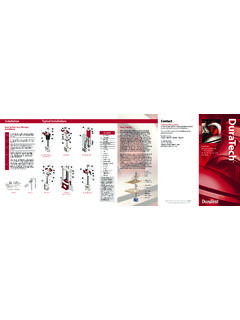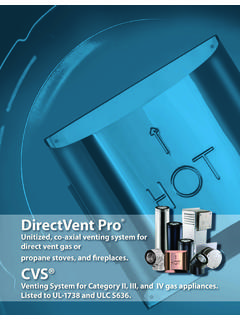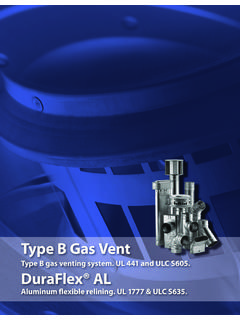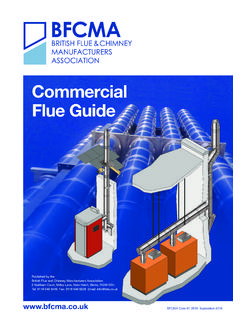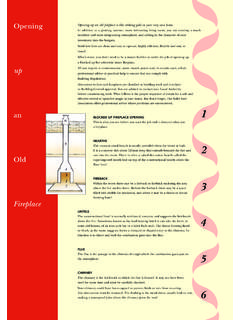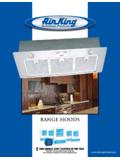Transcription of The relining of chimneys is a challenging task. Here are ...
1 chimney liners by John Gulland The relining of chimneys is a challenging task. Here are six key steps to help you make those critical decisions necessary to the job. 2005 4 SEASONS CHIMNEY SERVICE, STOUGHTON, MA. PHOTOS COURTESY: Installation of flexible liner . I ntroduction The installation of relining systems is challenging because it involves a num- ber of decisions that can make the installer responsible for the later performance and This paper proposes a series of prac- tical best practices to assist liner installers in making good decisions and to sup- port their efforts to inform customers Six best practices are proposed: 1. Reline for valid technical reasons. 2. Provide accurate, credible infor- safety of the system. The installer must on why specific recommendations are mation to the homeowner. answer a series of questions: made. The other goals are to raise the 3. Inspect the chimney carefully and Can the existing chimney be relined?
2 Quality and consistency of chimney lin- prepare it for relining . Will relining resolve the safety and ing services offered by trained techni- 4. Select the appropriate liner for performance problems that prompted cians and to promote the correct use of the task. action? products offered by chimney liner manu- 5. Insulate the liner except in What size and type of lining materi- facturers. The relining of chimneys serv- special circumstances. als and insulation, among the many ing wood-burning appliances is the main 6. Follow the liner manufacturer's options available, should be selected? focus, although these best practices also installation instructions and use What steps and equipment will be apply generally to chimney relining for components correctly. needed for installation. oil-, gas- and coal-burning equipment. 68 HEARTH & HOME OCTOBER 2005. chimney liners 1. Reline for valid that they have inspected the chimney technical reasons.
3 During cleaning or after a chimney fire There are several good reasons to reline and have determined that relining is an existing masonry chimney. needed. They then offer to sell and relining may be needed when there install the liner , raising at least the pos- is a change of use of the chimney, such sibility that the inspection findings were as the installation of a smaller, more made in order to sell the liner and not efficient appliance, or an insert into an because of a potential hazard or to existing fireplace. Ideally, the flue area improve performance. The installer can- should match that of the connected not entirely avoid the appearance of appliance. The nominal 8-by-12-inch conflict, but can manage the situation clay liner , the most common size in effectively to minimize it. most regions, has more than twice the One way to eliminate skepticism is cross sectional area of a 6-inch diam- to provide photographic or video evi- eter flue, which is the most common Stains like these are caused by conden- dence of the liner failure.
4 Another is size for modern wood stoves. Resizing sation of moisture and creosote from cool to be careful and deliberate in the the chimney flue with a new liner that flue gases. description of all conditions that jus- matches the size of the appliance flue tify the recommendation for relining . collar is a good reason for relining . Providing the reasons in writing or in Clay liners can fail because of ther- result, some last decades and others a hand-out sheet on relining are good mal shock caused by a chimney fire, deteriorate in a few years, so it is not strategies for increasing confidence in from attack by acids in flue gases, from possible to give an average life expectancy the legitimacy of the recommendation. freeze-thaw cycles in cold climates, or for clay tiles. Whatever the reason for Suggesting to the customer that they from general deterioration with aging. failure, relining is an appropriate solu- might wish to get a second opinion and tion for a chimney in which the brick or cost estimate demonstrates good faith stone shell is still in good condition but and may boost the customer's confi- the liner has failed.
5 Dence to the extent that they don't bother Signs of flue gas cooling, such as to act on the suggestion. water condensation, visible staining or On the other hand, the surest way rapid creosote formation are problems to increase skepticism is by attempting that can be addressed by the installation to use the fear of fire to frighten the of an insulated liner . These symptoms customer into purchasing the liner . The are often accompanied by weak draft, use of fear tactics is a common cause which tends to show up as slow burn- of complaints about companies pro- ing, fussy fires and smoke roll-out when moting liner installations. the door is opened for loading. While an insulated liner can be an important aspect 3. Inspect the chimney and of the solution, it may not be the total prepare it for relining . answer because these symptoms can also New liners should only be installed in result from poor fuel and operating prac- chimneys that are structurally sound and tices.
6 Ideally, when solving the problem fully cleaned of deposits. It is important of excessive flue gas cooling, relining is to clean the chimney thoroughly, includ- combined with good advice on fuel prepa- ing the removal of hard, baked-on cre- ration and appliance operation. osote. If left in place when the new liner Where inspection reveals evidence of is installed these deposits could outgas combustibility hazards such as inade- into the living space when subsequently quate clearance or the presence of embed- heated because there would no longer ded combustibles such as nailers or be a flow path to outdoors. In a severe beams supported in the masonry struc- ture, relining with a liner certified for zero clearance from the masonry shell to adjacent combustibles is a good solu- relining is common when there is a tion. Such liners are always required to change of use of the chimney, such as be insulated.
7 Note that, even when using the installation of an insert into an exist- a zero external clearance lining system, ing fireplace. there must be at least the equivalent of inches of solid masonry between the liner and combustible material. The most common signs of failure are cracks in clay liners and displacement 2. Provide accurate, credible of broken pieces. There are regional information to the homeowner. variations in the quality of clay used liner installers often find themselves Damaged crown and eroded mortar in the manufacture of clay liners. As a in an apparent conflict of interest, in joints should be repaired before relining . 70 HEARTH & HOME OCTOBER 2005. chimney liners case of heating, if the new liner were not insulated, the deposits could ignite, creating a potential hazard. Any deterioration of the masonry should be repaired before relining . Typical deterioration includes a loose crown or weak and eroded mortar joints.
8 Remove the original clay liner if necessary. If the clay liner is damaged or if the space it occupies is needed to accommodate the new liner and its insu- lation, it should be removed. Clay tile removal is a difficult and potentially dangerous job requiring the right tools and good planning. During the inspection and prepara- tion for relining , the flaws in the chim- ney should be revealed. Unused breeches and hidden combustibles are Flex liners are the most common type, and must be used for relining chimneys with offsets. ing of coal-fired appliances. other. The important point is that, in Stainless steel liners, of the kind suit- achieving a listing under UL 1777, both able for chimneys serving solid fuel- types of liner are subjected to the same fired appliances, are available in either temperature and corrosion tests and are rigid or flexible forms. In general, flex therefore considered to be equivalent.
9 Liners are made of thinner stainless steel Flex liner is the best choice if the of a higher grade than rigid liners. While chimney has an offset, since it is dif- a dealer or installer may prefer one or ficult and expensive to install an off- the other, there is no evidence to sug- set using rigid liner within a masonry gest that either rigid or flex liners per- structure. In straight chimneys , either form better or are more durable than the flex or rigid are acceptable. Rigid and flex liners can be insu- The chimney should be cleaned lated with either a fiber blanket or thoroughly before relining . a mixed insulation based on vermi- culite, depending on the terms of the product listing. The insulation used must examples of problems that can be dis- be clearly referenced in the liner instal- covered and corrected at this stage. Such lation instructions and must be installed problems should be corrected before exactly as described in the instructions.
10 Proceeding with the reline. The form of insulation and the way it is installed is critical because this affects 4. Select the appropriate liner the permitted clearances, both internal for the task. and external, as determined during safety A number of optional liner types are testing to UL 1777. available, each having special features Another form of certified liner is that can make it suitable in particular referred to as poured-in-place, solid situations. The basic requirement for any set. This cementatious liner material is liner is that it meet the requirements of pumped into place around an inflated UL Standard 1777, chimney liners , and rubber bladder or a vibrating former. is suitably listed and labeled. The label Once the forming device is removed, or stamp will specify whether the liner a smooth flue passage remains. The is suitable for Category 1 gas- or propane- liner material itself insulates because it fired appliances, for oil-fired appliances, has a vermiculite base.
